Household Tesla Coil
Having a pathological craving for plumbing fittings I just can’t teach myself how to use it for its intended purpose. Ideas always come to mind about what to make of pipes, fittings and adapters so that they will never be used in plumbing. So it happened this time. We make a high-voltage Tesla generator on plumbing fittings.
Why such a choice? Everything is very simple. I am a supporter of elegant and well-repeatable technical solutions. Minimum locksmiths, fine-tuning, dopilka, doklepki. Life should please with ease of decisions and grace of forms.
Everything was in stock in the store and the purchase took just a few minutes.
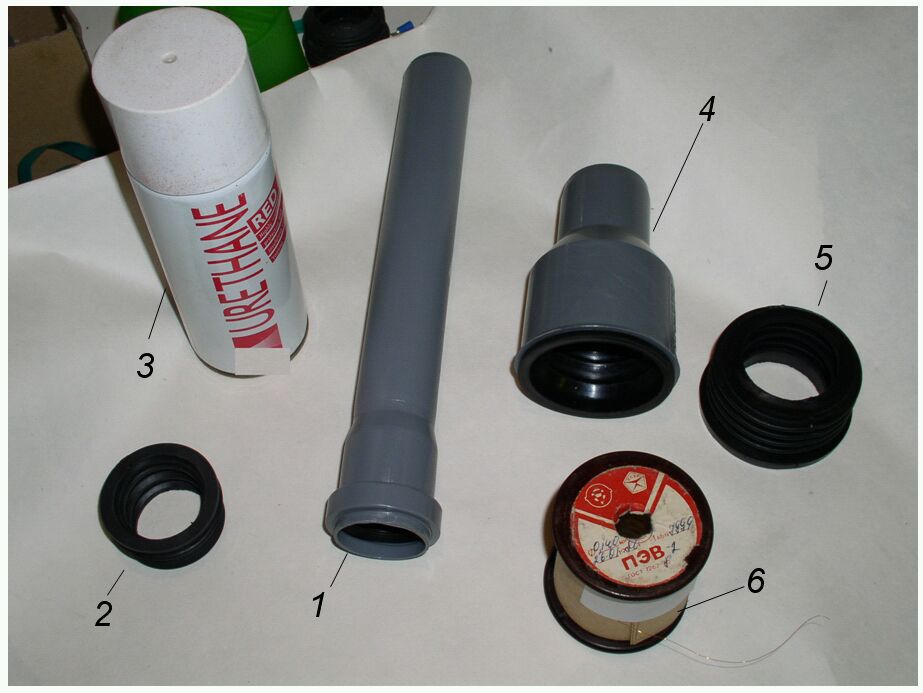
The picture shows everything that is needed. I give the original names from the store labels
1. Pipe 40x0.25m
2. Adapter ring to the pipe 40mm
3. High-voltage varnish (was in the arsenal)
4. Coupling to the smooth end of the cast-iron pipe 50mm
5. Rubber sleeve 50mm
6. Copper wire 0 , 14mm PEV-2 (from old stocks)
The cost of all accessories is about 200 rubles. When buying, it is better to choose a larger store, so as not to explain to guards and managers why you are connecting unconnected elements to each other and how to help you find what you need. We will also need some more inexpensive parts, about which a little later. But first, let's digress a little ...
Much has been said about Tesla and various things, but for the most part people (including myself) are unanimous in their opinion - Tesla did quite a lot for the development of science and technology for his time. Many of his patents came to life, part of it still remains beyond the grasp of understanding. But the main merits of Tesla can be considered a study of the nature of electricity. Especially high voltage. Tesla struck his acquaintances and colleagues with amazing experiments in which he easily and cautiously controlled high-voltage generators that produced hundreds of thousands, and sometimes millions of volts. In this article, I describe the manufacture of a Tesla miniature generator, the theory of which is fairly well and thoroughly studied. Now to the point!
In the end, we must assemble our device as shown in the photo:

We wind the main high-voltage coil onto the tube with a wire of 0.1-0.15 mm. I had 0.14 mm wire in stock. This is perhaps the most boring occupation. Winding must be done as carefully as possible, turn to turn. You can use a snap, but I wound the reels manually. By the way, I always do something in at least two copies. Why? First skill. The second product is obtained simply with candy, and there will always be a person who starts to beg for the device (give, sell, give use, etc.). I give the first, the second remains in the collection, the eye rejoices, friendship grows stronger, harmony in the world is growing.
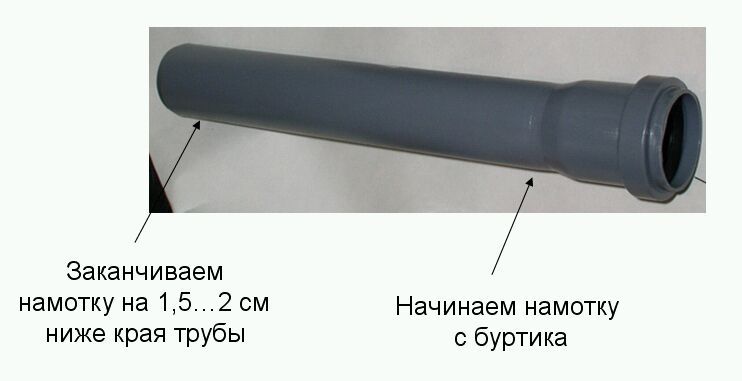
The next important step is the isolation of the high voltage coil. I will not say that it is necessary to soak the coil 20 times with wax, wrap it with varnish or use digestion in oil. All these are Kolchak’s approaches. We are modern people, so we use high-voltage varnish (see the first photo. I don’t indicate the varnish brand, you can google it) and wide heat shrink. We varnish in two to three layers. Dry the layer for at least 20-30 minutes. The varnish is applied perfectly. The result is great! The coil becomes just eternal! The cost of varnish is not great. Three hundred rubles balloon. I think enough for a dozen of these devices. BUT!!!
The varnish was VERY TOXIC!Literally a minute later my head ached and the cat began vomiting. The work had to be stopped. Ventilate the room immediately, stop applying varnish. Urgently had to run to the store. I need to buy beer, and a cat milk to recover from poisoning:

For good application of varnish should be carried out under the hood, but (after saving myself and the cat) I did it on the street. The weather was favorable, there was no wind and dust, and the rain did not pour. Then you need to put on a wide heat shrink and seat the coil with a hot air gun. This must be done carefully, from the middle to the edges. It should turn out tightly and evenly.
Perhaps the most critical part of the generator. I have analyzed many designs of such devices and many authors make the same mistake. Firstly, a fairly thin wire is used, and secondly, there is no uniform and substantial (at least 1 cm) gap with a high-voltage coil and many turns are used. This is completely unnecessary. Enough 2..4 turns in the first third of the high-voltage coil. For the inductor, we use a hollow copper annealed tube with a diameter of 8 mm, which ensures minimal inductance and simply excellent generator characteristics during operation. We wind three turns on a rubber cuff in grooves. So that the tube does not break up, fill it tightly with fine sand. After gently pour out the sand. After collecting the entire structure, everything should look like in the photo:
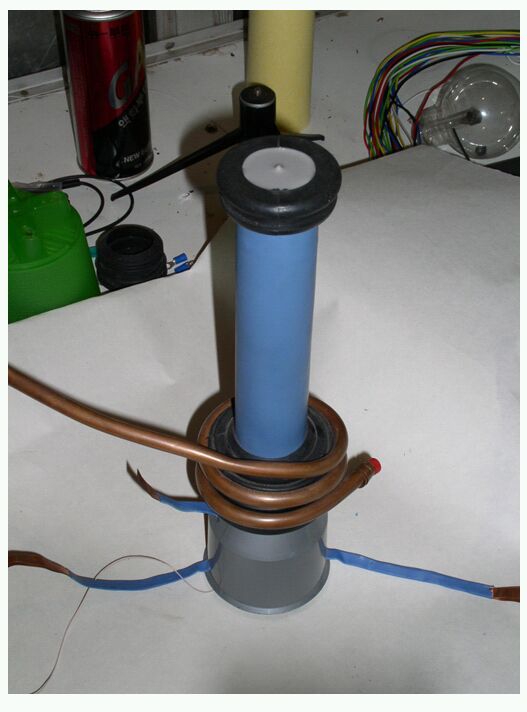
The copper pipe is perhaps the most expensive item in this homemade product. As much as 150 rubles. Purchased also in the household.
Subtleties associated with the design of the contacts of the inductor. They are made of annealed copper strip and are closed by heat shrink. This ensures minimal inductance of the structure, which is very important. The contacts are hidden inside the coupling. All joints should be as short as possible and made with wide copper tapes, which reduces various losses. We put an adapter ring on top of the device, which presses a round copper contact, onto which the upper output of the high-voltage coil is soldered. The structure at the top is molded with liquid rubber. A mini-jack is displayed in the center.
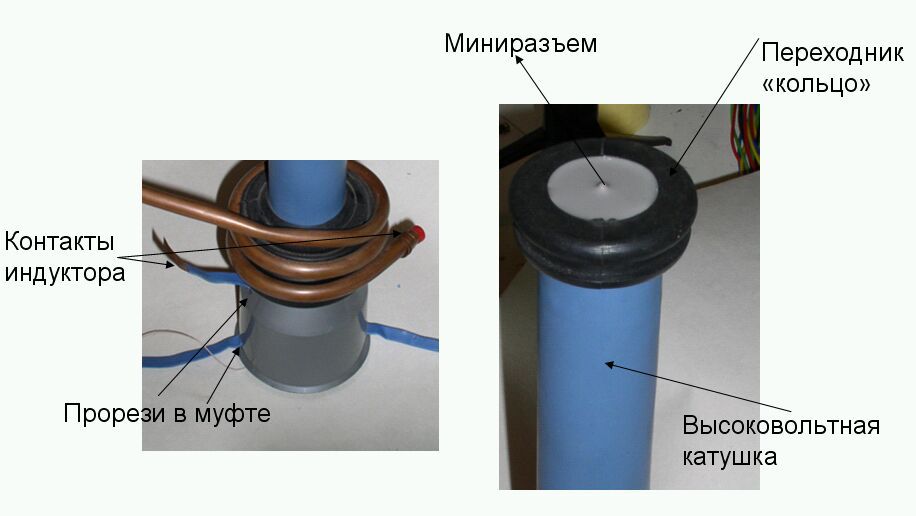
There are approximately 2 million ways to power such a device. Let us dwell on the simplest - using the circuit shown in this figure: You will
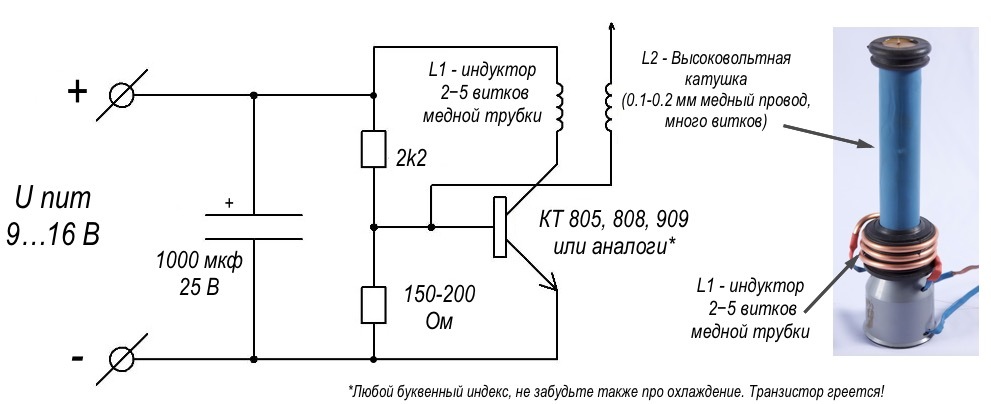
need a pair of resistors, a capacitor, a transistor, do not forget to put it on the radiator. Denominations are indicated. The resource of the circuit, I think, is not large, but given the low cost of transistors and the urgency of the desire to see the result, this does not count.
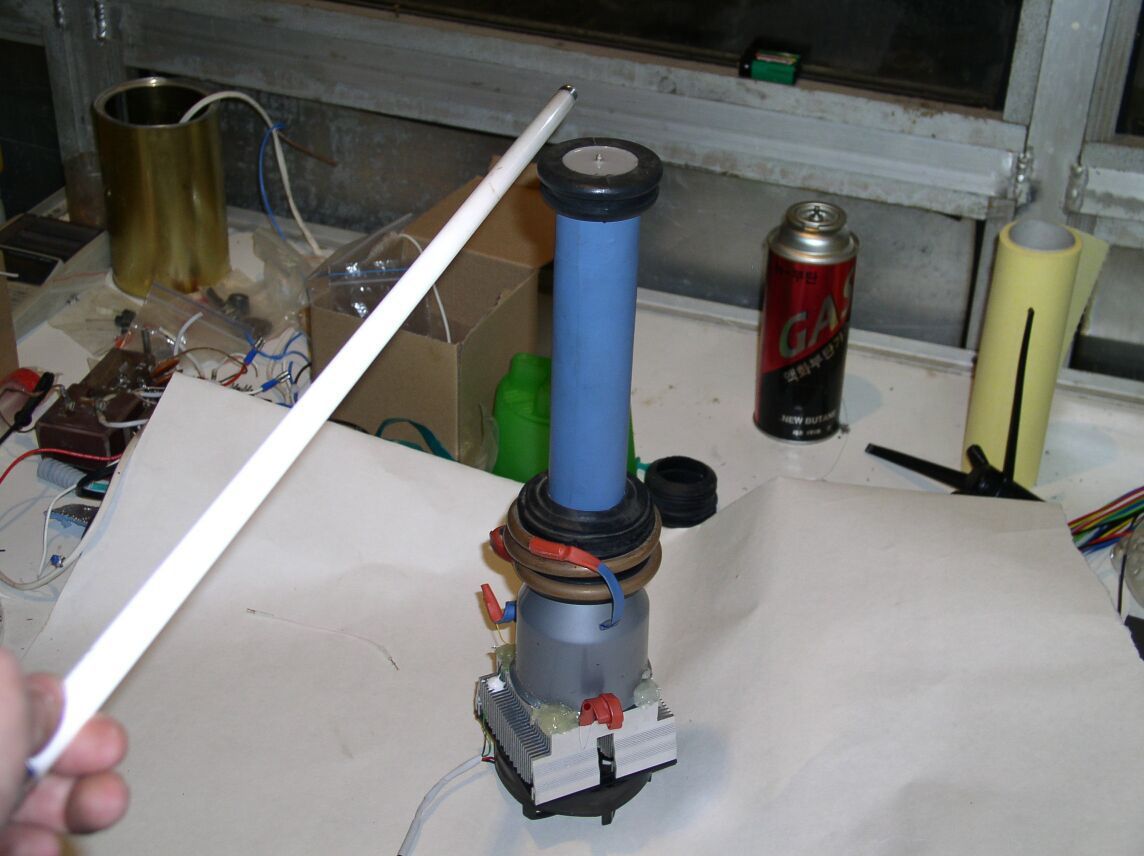
If everything is assembled correctly, the scheme will work immediately. If there is no generation, then reverse the contacts of the inductor. It worked for me right away. Generation starts with 5-7 volts. Already at 6 volts the generation is stable, at 12 volts everything burns around. In the photo you can see that the whole structure is blown by a fan, since the transistor is pretty hot, although it is mounted on a radiator. Surprisingly, the circuit is very reliable. It works for 12 volts for hours and is very stable. When the light is off and the "dead" bulb shines brightly. The power source for the coil is better to take more powerful (with an output current of at least 2-3 amperes).

You can watch the video of the device here .
Let's not forget about security. Similar devices within a radius of 2-3 meters can easily disable fine electronics, such as a mobile phone, an electronic watch on your hand, etc. A person is affected by a high-frequency high-voltage generator weakly due to the "skin effect", but be careful. Children, cats, birds and unbalanced citizens should be at some distance from such devices when they are turned on.
Remember this!
PS - At the request of some readers, I add a video with some details of the coil design. Video is available here .
Why such a choice? Everything is very simple. I am a supporter of elegant and well-repeatable technical solutions. Minimum locksmiths, fine-tuning, dopilka, doklepki. Life should please with ease of decisions and grace of forms.
What do you need?
Everything was in stock in the store and the purchase took just a few minutes.

The picture shows everything that is needed. I give the original names from the store labels
1. Pipe 40x0.25m
2. Adapter ring to the pipe 40mm
3. High-voltage varnish (was in the arsenal)
4. Coupling to the smooth end of the cast-iron pipe 50mm
5. Rubber sleeve 50mm
6. Copper wire 0 , 14mm PEV-2 (from old stocks)
The cost of all accessories is about 200 rubles. When buying, it is better to choose a larger store, so as not to explain to guards and managers why you are connecting unconnected elements to each other and how to help you find what you need. We will also need some more inexpensive parts, about which a little later. But first, let's digress a little ...
Tesla coils and all that
Much has been said about Tesla and various things, but for the most part people (including myself) are unanimous in their opinion - Tesla did quite a lot for the development of science and technology for his time. Many of his patents came to life, part of it still remains beyond the grasp of understanding. But the main merits of Tesla can be considered a study of the nature of electricity. Especially high voltage. Tesla struck his acquaintances and colleagues with amazing experiments in which he easily and cautiously controlled high-voltage generators that produced hundreds of thousands, and sometimes millions of volts. In this article, I describe the manufacture of a Tesla miniature generator, the theory of which is fairly well and thoroughly studied. Now to the point!
What should we get?
In the end, we must assemble our device as shown in the photo:

Step 1. Winding a High Voltage Coil
We wind the main high-voltage coil onto the tube with a wire of 0.1-0.15 mm. I had 0.14 mm wire in stock. This is perhaps the most boring occupation. Winding must be done as carefully as possible, turn to turn. You can use a snap, but I wound the reels manually. By the way, I always do something in at least two copies. Why? First skill. The second product is obtained simply with candy, and there will always be a person who starts to beg for the device (give, sell, give use, etc.). I give the first, the second remains in the collection, the eye rejoices, friendship grows stronger, harmony in the world is growing.

Step 2. Insulation of the high voltage coil
The next important step is the isolation of the high voltage coil. I will not say that it is necessary to soak the coil 20 times with wax, wrap it with varnish or use digestion in oil. All these are Kolchak’s approaches. We are modern people, so we use high-voltage varnish (see the first photo. I don’t indicate the varnish brand, you can google it) and wide heat shrink. We varnish in two to three layers. Dry the layer for at least 20-30 minutes. The varnish is applied perfectly. The result is great! The coil becomes just eternal! The cost of varnish is not great. Three hundred rubles balloon. I think enough for a dozen of these devices. BUT!!!
The varnish was VERY TOXIC!Literally a minute later my head ached and the cat began vomiting. The work had to be stopped. Ventilate the room immediately, stop applying varnish. Urgently had to run to the store. I need to buy beer, and a cat milk to recover from poisoning:

For good application of varnish should be carried out under the hood, but (after saving myself and the cat) I did it on the street. The weather was favorable, there was no wind and dust, and the rain did not pour. Then you need to put on a wide heat shrink and seat the coil with a hot air gun. This must be done carefully, from the middle to the edges. It should turn out tightly and evenly.
Step 3. Manufacturing the inductor and assembling the entire structure
Perhaps the most critical part of the generator. I have analyzed many designs of such devices and many authors make the same mistake. Firstly, a fairly thin wire is used, and secondly, there is no uniform and substantial (at least 1 cm) gap with a high-voltage coil and many turns are used. This is completely unnecessary. Enough 2..4 turns in the first third of the high-voltage coil. For the inductor, we use a hollow copper annealed tube with a diameter of 8 mm, which ensures minimal inductance and simply excellent generator characteristics during operation. We wind three turns on a rubber cuff in grooves. So that the tube does not break up, fill it tightly with fine sand. After gently pour out the sand. After collecting the entire structure, everything should look like in the photo:

The copper pipe is perhaps the most expensive item in this homemade product. As much as 150 rubles. Purchased also in the household.
Some subtleties ...
Subtleties associated with the design of the contacts of the inductor. They are made of annealed copper strip and are closed by heat shrink. This ensures minimal inductance of the structure, which is very important. The contacts are hidden inside the coupling. All joints should be as short as possible and made with wide copper tapes, which reduces various losses. We put an adapter ring on top of the device, which presses a round copper contact, onto which the upper output of the high-voltage coil is soldered. The structure at the top is molded with liquid rubber. A mini-jack is displayed in the center.

Step 4. Connecting and testing the generator
There are approximately 2 million ways to power such a device. Let us dwell on the simplest - using the circuit shown in this figure: You will

need a pair of resistors, a capacitor, a transistor, do not forget to put it on the radiator. Denominations are indicated. The resource of the circuit, I think, is not large, but given the low cost of transistors and the urgency of the desire to see the result, this does not count.

If everything is assembled correctly, the scheme will work immediately. If there is no generation, then reverse the contacts of the inductor. It worked for me right away. Generation starts with 5-7 volts. Already at 6 volts the generation is stable, at 12 volts everything burns around. In the photo you can see that the whole structure is blown by a fan, since the transistor is pretty hot, although it is mounted on a radiator. Surprisingly, the circuit is very reliable. It works for 12 volts for hours and is very stable. When the light is off and the "dead" bulb shines brightly. The power source for the coil is better to take more powerful (with an output current of at least 2-3 amperes).

You can watch the video of the device here .
It’s not beer that kills people ...
Let's not forget about security. Similar devices within a radius of 2-3 meters can easily disable fine electronics, such as a mobile phone, an electronic watch on your hand, etc. A person is affected by a high-frequency high-voltage generator weakly due to the "skin effect", but be careful. Children, cats, birds and unbalanced citizens should be at some distance from such devices when they are turned on.
Remember this!
PS - At the request of some readers, I add a video with some details of the coil design. Video is available here .
